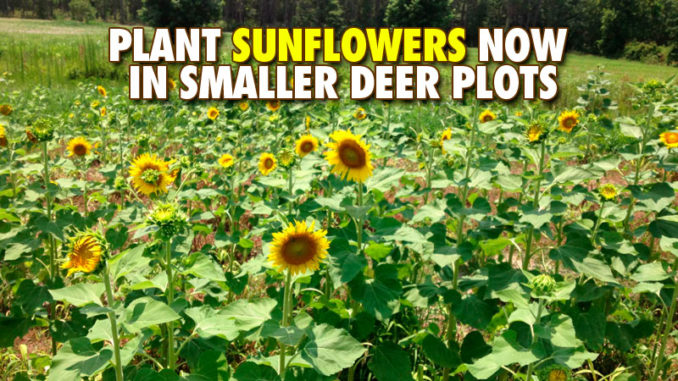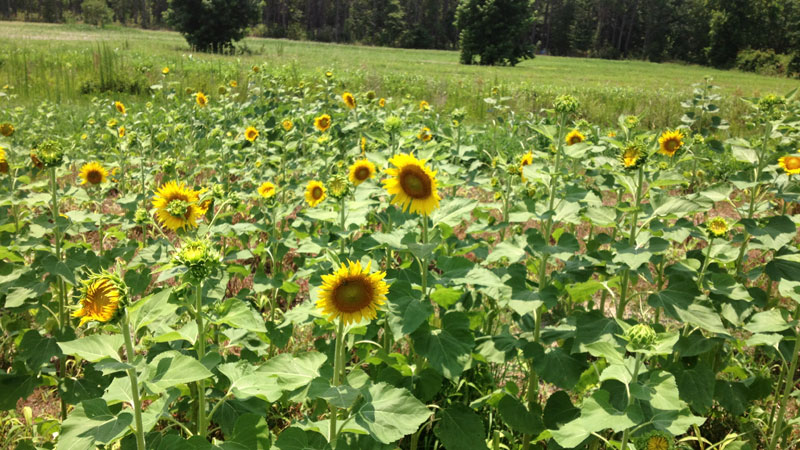
Deer love sunflowers, and fall is a great time to plant them
Plant sunflowers for deer?
What!?
Yes, sunflowers have a 90- to 120-day maturation period and are usually planted in the late spring for a September dove field. But anybody who has planted sunflowers for doves knows how much deer like sunflowers. They absolutely love sunflower plants when they are young and tender. As soon as the little green shoots peak out of the soil, deer show up and start to terrorize them.
Sunflower plants are very tasty to deer and offer an excellent source of nutrition when available. They are something that deer rarely get in the wild. And they will go out of their way to feast on these tender shoots and leaves. Deer will begin to use sunflower food plots as soon as they come out of the ground. It’s the perfect early season food plot to coincide with the early parts of deer season in many counties in the Carolinas.
But, don’t expect it to last long. Sunflowers don’t resist aggressive browsing and will generally die after heavy browsing or during the first night of freezing temperatures. For the hunter looking for a seed to plant in a small, remote plot for October hunting, a heavily stocked field of sunflowers is a good way to go. Just be ready when the field is planted. The deer will come to it like a Sunday buffet as soon as it erupts.
The sunflowers won’t mature, but they’ll bring the deer to you
This is one case where planting-density recommendations can be ignored. That’s because carrying this planting out to full maturation is not a part of the plan. If the typical seeding rate may be 20 pounds per acre drilled and 25 pounds per acre broadcast, land managers can increase the seeding rate by 50 percent. This encourages a dense plot and a heavy browsing site.
Just don’t buy the most expensive seed around. The sunflower plot will be short-lived. But the feeding frenzy will be fast and furious and a great place to pull in a giant.
After the field has been destroyed by deer and several wall-hangers have gone to the taxidermist, land managers should re-plow and plant with oats or rye for a longer-lasting winter crop.
Don’t over-populate plot!
With the fall planting season in full swing, managers have a long list of variables to consider before burying the first seed. One of the most-important considerations is the seed population.

The seeds themselves don’t really need a ton of room to germinate in their infant stages. But as they grow on the road towards maturity, they utilize more resources and require more room. Seeding rates will directly affect the plot’s performance.
Planting rates are primarily determined by the size and requirements of the mature versions of plants. Some seeds can be planted very close together. Others need significant space to grow vigorously and produce the most forage.
Some seeds, like pine tree seedlings, are planted relatively close together, on purpose. This technique encourages vertical growth while discouraging lateral growth as much as possible when juvenile. Plants will grow towards the light. And when the only light is directly above, plants will grow upwards towards the sun. Large, living branches flourishing along the trunk create knots and poor-quality lumber.
As the timber grows towards the sun and gets larger, trees are selectively harvested through thinning to allow residual trees to access all available nutrients. This encourages lateral growth with only a limited coverage of living limbs present on the lower portion of the tree.
Measure plot sizes accurately
Nevertheless, growing food plots is much different than growing pine trees, where significant vertical growth is not required, nor warranted. In fact, food-plot plant species need room to spread out and produce as much green foliage as possible. Green foliage is covered in photo receptors. And every receptor allows plants to convert the sun’s rays into viable energy.
Seeding rate will also change by planting method. Since broadcast seed has a poorer germination rate, it will need a higher application rate than when planted with a seed drill or machine planter. Mechanized seed drills and planters are precise devices. And the seed density and planting depth can be controlled accurately. When using row planters and seed drills, the seeding rate is generally half of the broadcast rate.
Seeding rates are listed in pounds per acre. Plots must be measured accurately to determine the true area, based on what percentage of 43,560 square feet — an acre — is to be planted. Only then can you prescribe the amount of seed to be used for the area to be planted.
Don’t overplant the site
Different seed types require different seeding rates. Some seeds will weigh more than others, so the seeding rate in pounds per acre will vary by seed type and variety. For example, grain sorghum and sunflowers generally require a broadcast seeding rate of around 8 pounds per acre. Wheat and oats are usually broadcast planted at around 50 pounds per acre. Always check the label to make the proper seeding rate.
Lastly, seeding rates should always be reduced when creating planting blends. For the best results, use the seed with the higher seeding rate per pound as a base. Then make adjustments from there.
When in doubt, always err on the side of caution when determining seeding rates. You should lower the seeding rate to make sure the plants aren’t overstocked. Overplanting a site will produce less than desired results.
Pre-inoculated legumes
Legumes are one of Mother Nature’s wonderful plants. They provide excellent nutrition for wildlife, and improve soil conditions. They are typically a palatable source of protein and rich, green browse that deer will gravitate to on any property. Legumes include clovers, peas, beans, lespedeza, peanuts and alfalfa. They have a symbiotic relationship with soil bacteria where soluble nitrogen is produced and usable to the plants. Nitrogen is one of the top three soil nutrients critical to life.
The nitrogen-fixing bacteria in the soil is somewhat available naturally. But planters can kick-start the nitrogen generator in the soil through inoculation. Essentially, inoculation is the introduction of live nitrogen-fixing bacteria to the seeds. It can be added to the seeds before planting. But some suppliers offer seeds pre-inoculated in the bag.
Applying inoculant isn’t a tough task. But it adds a few extra steps to the process that will delay planting. That’s because the seeds must be coated with a wet solution and then dried enough to function in row planters and broadcast seeders. Purchasing pre-inoculated seed can eliminate these steps and make planting a little more streamlined when the planting window is wide open. But, never avoid using inoculated seed if purchased that way or inoculating bare manually. Inoculated legume seed will get the food plot off and into production right away.









